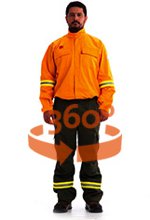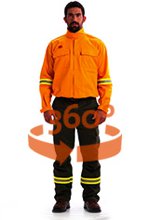WILDLAND FIREFIGHTER GEAR
This uniform made of NOMEX® RipStop is perfect to confront wildland fire. Every detail was designed considering all the risks involved.
Yellow shirt with collar with a flap to provide more protection, two patch pockets with flaps, snap button closures not exposed adjustable cuff and FR reflective tape on arms and back.
Green cargo pants with knee reinforcement, Bellows crotches for more flexibility, two patch pockets, two side cargo pockets and two back patch pockets with flaps and snap closure. FR reflective tapes on each leg. Bar tacked, double and triple stitched with FR thread to provide a better tear and fire resistance.
Yellow shirt with collar with a flap to provide more protection, two patch pockets with flaps, snap button closures not exposed adjustable cuff and FR reflective tape on arms and back.
Green cargo pants with knee reinforcement, Bellows crotches for more flexibility, two patch pockets, two side cargo pockets and two back patch pockets with flaps and snap closure. FR reflective tapes on each leg. Bar tacked, double and triple stitched with FR thread to provide a better tear and fire resistance.

Es una normativa estadounidense que establece los estándares de performance que deben cumplir las prendas y demás elementos de protección usados por el bombero al enfrentar un incendio forestal potencial.

American standard for garments that protect from flash fire. The standard demands that after being washed a hundred times, the garment is put on a mannequin and exposed to 3 seconds of direct flame. In order to accomplish the standard the result must show less than 50% of body burn.

American standard which establishes that employees who are exposed to a possible arc flash should wear appropriate flame resistant garment for the risk level of their workplace. Employers must evaluate an arc flash to determinate the risk of potential energy and the limit of protection against the arc flash.
The protective garment should cover the calculated incident energy or risk level, reaching at least its minimum ATPV.
Arc Thermal Performance Value - ATPV
Arc Thermal Performance Value - ATPV
- Level 0: No risk
- Level 1: between 4 to 7.9 cal/cm2
- Level 2: between 8 to 24.9 cal/cm2
- Level 3: between 25 to 39.9 cal/cm2

The standard classifies High-Visibility Safety Apparel (HVSA) as Performance Class 1, 2 or 3, depending on the amount of visible background and retroreflective material. These Performance Classes give users a way to specify HVSA that is appropriate for the work environment and hazards. The 2015 edition also establishes three types of garments:
- Type O (off-road), for non-roadway use, where workers are not exposed to high traffic or temporary control zones. Type O HVSA is Performance Class 1.
- Type R (roadway), for use where workers are exposed to traffic from public access highway rights-of-way or roadway temporary control zones. Type R HVSA may be Performance Class 2 or 3.
- Type P (public safety) for emergency and incident responders and law enforcement personnel who are exposed to struck-by hazards in roadway or off-road work environments. These garments provide additional options addressing competing hazards or the need for access to special equipment. Type P HVSA may be Performance Class 2 or 3
Certificados por AITEX bajo ISO 16073

 EN
EN  ES
ES 


 ©Copyright 2025 Geotex SRL
©Copyright 2025 Geotex SRL